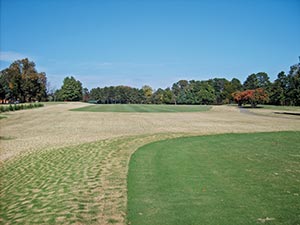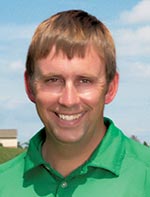Fertilizing for the future
Superintendents can simplify fall fertilization with control and slow release fertilizers, producing green and healthy turf for the following season.
Different climates, root-zone mix composition, golfer expectations and budgets all play a role in today’s modern golf course, turning something as important as fertility management from an art form to a science. And with recent advances in the understanding of nutrient behavior, smart superintendents are putting even more science into the process.
Who knew something as simple as fall fertilization could be so complicated? And the big question — with so many fertilizer choices readily available, what’s the most efficient and cost effective way to manage fall fertilization for your course?
Todd Lederer, superintendent for the town of Mooresville, N.C., brings 25 years of industry experience to his fertilization programs. When it comes to implementing successful fall fertilization programs, Lederer has found the two main factors — and an unlikely duo — are plant growth regulators and a controlled-release fertilizer.
“Plant growth regulators are as equally important in any fertility program regardless of weather conditions to yield a successful growing season,” says Lederer. “I have been using PGRs in our fall fertility programs for the courses’ greens, fairways and tees, and we have decreased mowing frequency and spikes in growth.”
In addition to PGRs and fertilizers, every year Lederer completes soil testing on the Moorestown course, which consists of taking soil samples, sending them to Harris laboratory, where it is analyzed to determine deficiencies of phosphorus (P) and potassium (K) pH levels.
Researchers at Penn State University have also noted that applying nutrients such as phosphorus and potassium in late fall can maximize root growth and plant maturation, as well as enhance turf’s hardiness, disease resistance and wear tolerance into the following summer.
“Nitrogen is what drives the uptake of nutrients and plant growth in the absence of heat or during stressful climate conditions,” says Lederer. “By testing our soils we determine what areas are deficient, which usually requires more phosphorus and potassium and we base our fertilization efforts for the following year off the results.”
Capitalizing on temperature
By using a controlled-release fertilizer, superintendent Bryan McBride of Moss Creek GC near Dayton, Ohio has successfully been able to get nutrients into the turf when the root zone needs it most. And by incorporating a thorough fall fertilization campaign, McBride is able to keep his turf’s nitrogen levels up year-round, allowing his turf to better fight disease through the entire year.
“I save on gas, time and labor by fertilizing in the late fall once with Spread it & Forget it controlled-release fertilizer,” says McBride. “The technology of the advanced polymer coating is activated by soil temperature. It just sits there after one application and the nitrogen release shuts down in cold soil so the granules do not release too soon.”
The patented polymer coating in Spread it & Forget it allows more consistent feeding in the fall, and preserves nutrients to be used during the spring green-up. The Moss Creek GC fairways and tees are dominantly bentgrass. To keep everything under growth regulation, McBride completes one application of a plant growth regulator in mid-September, taking his bentgrass into dormancy.
Enhancing spring green-up
Fall fertilization will also enhance spring green-up without the excessive growth that often accompanies early-spring fertilization. This green-up often will last into mid-spring, so an early spring fertilizer application is not needed.
“Fall fertilization is the most important fertilization of the year,” says McBride. “The plants need to have enough nutrients to make it through winter and come out strong in the spring. By giving the plant enough nutrients with a controlled-release fertilizer, I have been able to cut my fungicide budget and still have strong, healthy turf.”
“It is important to remember to fertilize turf before it undergoes stress,” says Bob Raley, Turf Agronomist, Agrium Advanced Technologies. “Fall feeding enables cool-season grasses to establish strong roots for the spring growing season and prepares grasses more effectively to survive stresses of the summer golf season.”
The best time to prepare greens to bounce back quickly in the spring is (depending on geography) during the late-fall; for McBride, he applies a controlled-release fertilizer in late-October, after the course has shut down for the season.
“Many superintendents go out three or four times with a slow release fertilizer, but I have been using Spread it & Forget it consistently for four years,” says McBride. “I apply it once per year on fairways, and every year I have, the course has less dollar spot and virtually no surge growth.”

Seen here are the fall application results from using Duration CR controlled release fertilizer on Mooresville’s greens and tees.
(Photo: Mooresville Golf Course)
McBride completes one granular application in the fall to target root systems, which physiologically is meant for primary nutrient uptake and will consistently feed the plant over a longer period of time. This gives plants an extra boost for winter, taking turf into the late spring. For tees he adds an all-mineral blend due to the additional wear and tear during the season.
“Because of the way controlled-release fertilizers are formulated, one application can meet all of our course needs for the season,” says McBride. “One year we had so much rain during the season and typically you would see surges in certain areas, but our course maintained smooth, even growth. Our golfers were very happy.”
Maximizing root growth
Fall fertilization yields an increase in rooting, maximizing root growth of cool-season turfgrasses that occurs in spring and fall. Some root growth will occur in winter if temperatures are above freezing, whereas little if any growth occurs in summer. During fall fertilization in most regions the roots are still growing at a time when shoot growth has ceased, thus allowing the roots to make full use of the fertilizer.
“When fertilizer is applied in late fall there is an increase in the plant’s carbohydrate reserves that occurs,” says Raley. “Turfgrasses accumulate carbohydrates in stems and roots during fall, which gives turf a slight advantage to resist winter injury and aid in disease and environmental stress resistance the following spring and summer.”
When deciding on a fall fertilizer program, remember to consider climate and grass type to determine what will work best on the course. Slow- and controlled-release fertilizers effectively deliver more nutrients to intended plants when needed —nutrients stay in the root zone and feed the plant at the root, which results in green, healthy turf in fall and spring, while promoting disease resistance in the summer.
Mooresville GC’s fall fertilization schedule
Aerification
⦁ Bentgrass greens mid-September
⦁ 419 Bermuda tees and fairways mid-July
Primo Maxx – Plant Growth Regulator
⦁ Applies on greens September-November using GGD (growing degree day method)
⦁ Applies on fairways and tees June-September every 18 to 21 days
Duration CR Controlled-Release Fertilizer
⦁ Applies one pound of nitrogen/1,000 sq. ft. in a controlled-release fertilizer and a granular soil conditioner with humic acid to regulate the soil pH levels
⦁ Depending on weather and turf conditions, in mid-October Lederer applies an additional 0.5 pounds of nitrogen/1,000 sq. ft. across his course
⦁ Fairways – 2.5-3.5 pounds/1,000 sq. ft. of nitrogen
⦁ Greens and tees – 3.5 -4.5 pounds/1,000 sq. ft. annually
Why controlled-release fertilizers work
Fertilizer manufacturers accomplish a controlled- or slow-release reaction with compounds that bind with the highly soluble nutrient sources or by encapsulation of the fertilizer source within a water-insoluble coating. The purpose of a controlled-release fertilizer is to prevent 100-percent release of the nutrients immediately following application, but instead to promote metered feeding, based on soil temperature.
Industry-leading products release their nutrients through a propriety polymer coating, and by varying coating thicknesses water can move through the coating at different speeds to the nutrients inside. This extends the time of feeding, ensuring nutrients are delivered when the plant’s root zone is most ready to absorb the nutrition.
Eric Miltner is a Turf Agronomist at Agrium Advanced Technologies. He can be reached at emiltner@agriumat.com.









